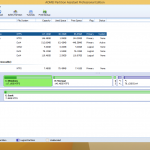From Quill to Cartridge
The evolution of printing and recording is complicated, interesting and long. Mankind has always wanted to retain what they observe experience. The human’s wish to record events is a habitual one and was practiced even by the early troglodyte. The Paleolithic age to its credit has carvings to admonish us of our origins and more than that it pointedly spread knowledge. Instead of just limiting their cognizance, they sought to dissipate it – to connect better and develop an ameliorated understanding to what lay around them.
The earliest form of elucidated printing was in the form of the IClay – the world’s first tablet reproduced by the Sumerians. One of the primary urban civilizations, the Sumerians flourished in the historical arena of Southern Mesopotamia (present day Southern Iraq). Their purpose to ‘document’ data was to invent writing for the enhancement of language. Round cylinder seals were utilized to roll impressions on to clay tablets. By AD 868 the Diamond Sutra was recorded, which was the world’s earliest and first printed book to be published. Exactly, dating back to May 11, 868, the book pertained to the T’ang dynasty. The scroll is about 16 feet in length and a foot in height and was accidentally unearthed in a cave at Dunhuang in the early 19th century.
By 1397 AD, type characters that used cast metal were being printed in Japan and China. Bed & Platen printing was an American backbone invented by Daniel Treadwell, who even patented the model. Subsequently, in 1832 Hoe’s Cylindrical-Bed Press was created by Richard Hoe that was much faster. A patent had already been filed by William Nicholson in 1790 for a rotary press for which Richard Hoe invented the drum that surpassed the earlier designs in 1844. William Bullock, also an American inventor, improvised Richard Hoe’s Rotary Printing Press and revolutionized the printing industry by incorporating speed and efficiency into print production. He placed continuous and large rolls of paper into curved stereotype plates built to hold them.
It was only with Johannes Gutenberg’s invention that mass communication took a turn for the better marking the Western Culture’s need to disseminate ideas, information and knowledge from a single source to large sets of audiences. It was an amazing confluence of culture, social, psychological, political and technological forces that had unfurled over several centuries that conceptualized into mass communication. Gutenberg was a goldsmith and a business man who even borrowed money to break the printing gridlock. A wave of change spread rapidly across Europe beginning in the 1450s leading to a strong desire of documentation with the expansion of trade and economy. In 1889, a Linotype/Monotype machine was invented in Gutenberg’s workshop that printed complete sets of lines. Between 1906 and 1911 the Monotype and Linotype designs were infused into the keyboard of a typewriter. Chester Carlson in 1938 invented a process of printing images with the help of a dry toner powder and an electrically-charged drum. The original name of the Xerox was ‘xerography’, which actually meant dry printing. Thereafter, the first high-speed printer was manufactured by Remington-Rand in 1953 for being used on Univac or Universal Automatic Computer. Around the same time, Daisy S. Lee of Diablo Data invented the Daisy Wheel Printer, which was an impact printing technology. It worked on the same doctrine as the ball-head typewriter.
By 1970, print technology gained relevance when one of the first Dot Matrix printers the LA30 was produced by Digital Equipment Corporation. The technology used dots instead of complete keys to print characters on paper. In 1971, the first laser printer EARS (Ethernet Alto Research Character generator Scanned laser output terminal) was invented by Gary Starkweather within just a few months of his joining PARC. It worked on the foundations of the Xerox Copier Technology but with an added a laser beam. In 1984, the first HP LaserJet entered the market and was the first desktop laser printer. Inkjet printers were a part of intelligent technology smart revolutionized printing as we know it today. And so in 1988, the first inkjet printer was invented that offered high-quality and continuous plain-paper printing.
Between 2003 and 2009, the digital era arrived and there was a swift progress in printing technology. Zoho Corp gave the world Additive Manufacturing otherwise known as 3D printing. In the same year, The Eastman Kodak Company also known as Kodak introduced the first Printer-And-Camera-Dock and the Easy Share Printer. Users could insert their cameras into a device provided to them and watch photos print themselves out. Epson went a step ahead again in the same year by introducing wireless printers and granted humanity the freedom of mobility. Finally, in the year 2009, Xerox introduced the Colorqube Technology that made the world colorful, because printouts were now in color.
The future is definitely bright for printing technology with the advent of a range of devices that turn digital 3D models into solid objects.








![6 Tips to Choose the Best Restaurant POS System [Infographic]](https://technofaq.org/wp-content/uploads/2016/12/6-Tips-to-Choose-the-Best-Restaurant-POS-System-01-150x150.png)






